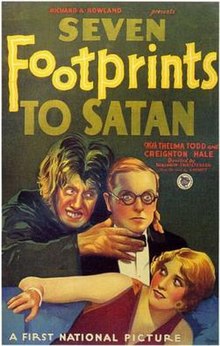Seven Footprints to Satan
| Seven Footprints to Satan | |
|---|---|

theatrical release poster
|
|
| Directed by | Benjamin Christensen |
| Produced by | Richard A. Rowland |
| Written by | Benjamin Christensen |
| Based on |
7 Footprints to Satan (1928 novel) by Abraham Merritt |
| Starring |
Thelma Todd Creighton Hale William V. Mong Sheldon Lewis |
| Cinematography | Sol Polito |
| Edited by | Frank Ware |
|
Production
company |
|
| Distributed by | Warner Bros. Pictures |
|
Release date
|
January 27, 1929 (silent) February 17, 1929 (sound) |
|
Running time
|
60 minutes 6 reels (5,405 feet) |
| Country | United States |
| Language | English |
| Budget | $129,950 |
Seven Footprints to Satan is a 1929 American horror film directed by Danish filmmaker Benjamin Christensen. Based on the book of the same name by Abraham Merritt, it stars Thelma Todd, Creighton Hale, William V. Mong and Sheldon Lewis, and contains appearances by Sōjin Kamiyama and Angelo Rossitto among others. It was produced as both a silent film and as a part-talkie, making it one of the last – if not the last – silent horror films.
Jim and Eve, a young society couple, are kidnapped on the eve of Jim's departure for Africa and brought to a mansion that is home to a strange and glamorous Satanic cult.
Cast notes
Seven Footprints to Satan is the fifth of seven films made by Christensen during his tenure in Hollywood, and is one of only four that survive in a relatively complete state (Eagle's Nest and Haunted House are believed to be lost; House of Horror exists only in sound elements).
Seven Footprints to Satan was released as both a silent film and as a sound film with Vitaphone musical score (after first talking picture The Terror (1928), sound effects and some dialogue sequences. The film received generally negative reviews, including from such publications as The New York Times, Variety – which called it "An utterly moronic sound film ... all hokum" – and the Philadelphia Inquirer, in which Mildred Martin wrote "after all the screams and creaks and thumps it reaches a somewhat tame conclusion..." Despite this it performed well at the box office. A companion "Photoplay" edition of the Merritt novel, published by Grosset & Dunlap and featuring several stills from the film, also sold extremely well.
...
Wikipedia
